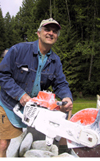 Hand tools, yeah! One arm swings the hammer; the other braces the point or claw. This drum beat sends us on a journey into the stone. It’s primitive, direct, a linking of human spirit to the earth itself. It’s that pulse and flow, that ancient meter that pushes deeper into the stone, producing a connective rhythm, a groove getting closer to form. Hand tool Junky! The purist quietly smiles, the power junky searches for yet a bigger blade (yes, I did buy the big saw).
Hand tools, yeah! One arm swings the hammer; the other braces the point or claw. This drum beat sends us on a journey into the stone. It’s primitive, direct, a linking of human spirit to the earth itself. It’s that pulse and flow, that ancient meter that pushes deeper into the stone, producing a connective rhythm, a groove getting closer to form. Hand tool Junky! The purist quietly smiles, the power junky searches for yet a bigger blade (yes, I did buy the big saw).
And yet, even the simple steel chisel or point requires some maintenance. Sharpening the edge with a hand stone suffices for a while. A bench grinder corrects even more. Eventually the edge or point is worn beyond the quick fix and the tool no longer functions for us. We brace up the credit card and look for the favorite tool store to give us another chance, another dancing partner with a special kind of magic, at a price of course.
But Wait! Remember those halcyon days of yore, you and your comrades gathered around Camp B, sparks rising through the air as a bellow handle spins the coal fire to life. Alphonso directing, his shouts like Latin lyrics over the harsh metallic clave from Chuck-o’s two handed power swing. The pavilion jumps to their tempo. A writhing bar of plastic metal changes shape. A transformation, “scrap” to “tool” in just a few blows. It is the magic of fire, my friend: the forge. I’ve assisted this process, built the fire, turned the handle, danced with joy when it all went right. A forge can allow us to repair, modify, or custom create the tempered steel tools used in stone sculpting. Fueled by propane or coal, the forge creates enough heat to anneal, shape, and temper tool steel. My enchantment goes back to childhood memories of turning the blower handle for grandfather, while he worked some magic with various metals.
I was recently gifted with a small farm forge, similar to the one used at Camp B and by my grandfather. Hard, low sulfur coal is available at a Chehalis heating supply. A small kindled wood fire builds up enough heat to start the coal burning. Place additional pieces around the perimeter of the fire pan, so the heat will drive off impurities and begin the coking process. It takes about an hour to get a good coal fire going. Coal forges should be fired outdoors. They emit noxious fumes.
A great way to take a break from the studio on a crisp winter day! I will be putting together an article reviewing heat-treating procedures in the future. There is a wonderful website for anyone interested in building or using a forge. http://www.anvilfire.com has pages full of plans, projects, discussions, tools, links to other sites, coal sources, tutorials, etc. . . . Friendly smiths, farriers, and metal work artisans offer the sage advice. They have some interesting discussions on safety that are applicable to stone workers.

